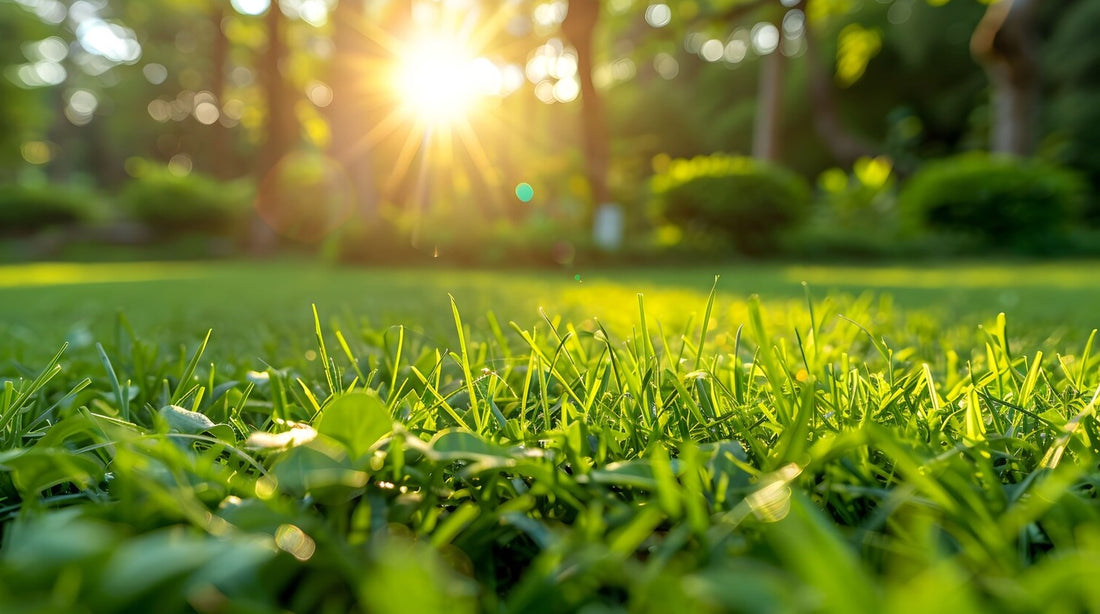Maintaining a healthy, vibrant lawn in North Carolina requires knowing the right time to fertilize. If you're wondering when to fertilize lawn in nc, and you have a tall fescue lawn, you've come to the right place.
At Lawn Synergy, we're dedicated to helping homeowners like you achieve lush, green lawns that enhance curb appeal.
In this article, we'll dive into the best seasons for fertilization, how North Carolina's climate impacts lawn care, and the specific fertilization schedule you should follow to keep your grass thriving all year round.
So, if you're ready to take your lawn care to the next level, keep reading!
What this article covers:- The Importance of Lawn Fertilization
- The Fertilization Schedule for Lawns In North Carolina
- Understanding the Grass Types in North Carolina
- Other Factors to Consider
The Importance of Lawn Fertilization
Lawn fertilization is essential for more than just aesthetics; it directly impacts the health and longevity of your grass.
By providing key nutrients, fertilization strengthens grass from the roots, promoting vigorous growth and enhancing its ability to resist pests and diseases.
Our findings show that properly fertilized lawns are more resilient to drought conditions and have a stronger ability to suppress weeds naturally, reducing the reliance on herbicides.
This means less maintenance and fewer chemical interventions, making fertilization a critical part of maintaining a healthy and sustainable lawn.

The Fertilization Schedule for Lawns In North Carolina
Based on our observations, the ideal fertilization schedule for North Carolina lawns varies depending on the season and lawn type. Let's break it down:
Fertilize In Early And Late Spring
Fertilizing in early and late spring is crucial for encouraging strong growth and preparing your lawn for the warmer months.
As the soil begins to warm in early spring, your lawn emerges from dormancy, and this is the ideal time to apply a balanced fertilizer like our Guardian 13-0-10 Pre-emergent Fertilizer.
This lawn fertilizer is designed to jumpstart growth by providing essential nutrients, including 13% Nitrogen, which enhances your lawn's deep green color without promoting excessive growth. It also contains pre-emergent which will prevent any weed seeds from germinating. It is important to apply this blend before soil temperatures reach 55 degrees consecutively. Apply a second application 6-7 weeks after for solid weed protection into the summer months.
The slow-release technology in the 13-0-10 formula ensures a consistent nutrient supply over time, preventing over-fertilization and reducing the risk of fertilizer burn.
This blend not only strengthens your lawn but also increases its resistance to disease and stress. For optimal results, we recommend a second application in late spring to maintain the lush, green color and prepare your lawn to handle the summer heat.
Additionally, we include organics in our fertilizer which nourishes the soil, enriching the habitat for essential microbes that support healthy grass growth year-round.
Apply Again During Early And Late Summer
Summer presents challenges for maintaining a healthy lawn, as the heat and potential drought conditions can cause significant stress to grass.
We recommend applying fertilizer in early summer to strengthen your lawn's drought resistance and provide the nutrients needed to endure the hotter months.
A third application in summer is equally important, as it helps the grass recover from heat stress and prepares it for robust growth in the fall. Our Emerald 10-0-20 Fertilizer with Iron is just the right blend during the summer months. It provides dark green color, slow-release nitrogen, and plenty of potassium for strength and disease resistance.
This two-step approach ensures that your lawn remains resilient during summer and is ready to thrive as cooler temperatures approach.

Fertilize During Fall
Fertilizing your lawn in the fall is essential for cool-season grasses, as it helps them prepare for the colder months ahead.
Fall fertilization strengthens the root system, allowing your lawn to store vital nutrients that will sustain it throughout winter and promote healthy growth when spring returns.
We recommend applying starter fertilizer in early fall, as this timing provides the nutrients your lawn needs to thrive and feeds overseeded lawns with everything they need to bring them back to life after the heat of summer.
By focusing on root development in the fall, your lawn will emerge stronger and healthier when the growing season begins again.
After overseeding, once new seedlings have germinated, wait 6 weeks and fertilize again with 20-0-10 to continue to feed the lawn, encouraging growth and continued root development. At this time the lawn will be screaming green.
Last Application In Early Winter
Applying a final round of fertilizer in early winter provides your lawn with the extra nutrients it needs to endure the colder months. This is particularly beneficial for warm-season grasses, which enter dormancy during winter.
By delivering a nutrient boost before freezing temperatures set in, you strengthen your lawn's root system and enhance its resilience, ensuring it stays healthy and ready to grow when warmer weather returns.
A well-timed early winter application helps maintain a strong foundation, allowing your lawn to emerge from dormancy in better condition for the next growing season.

Understanding the Grass Types in North Carolina
North Carolina's diverse climate supports a range of grass types, with both cool-season and warm-season grasses thriving in different parts of the state.
Cool-season grasses, such as fescue, are well-suited to the western regions, while warm-season varieties like Bermuda and zoysia are more common in the eastern areas.
Understanding your specific grass type is essential for ensuring proper fertilization and maintaining a healthy lawn.
For example, the timing for when to fertilize zoysia grass in Texas differs from North Carolina due to variations in climate.
Similarly, knowing when to fertilize lawn in florida or when to fertilize lawn in michigan requires adjustments to accommodate their unique weather patterns. This makes it crucial to tailor your fertilization schedule to your local conditions for the best results.
Other Factors to Consider
When it comes to fertilizing your lawn, timing is important, but other factors should also be considered to ensure optimal results:
- Soil Test: We recommend conducting a soil test before fertilizing. This will provide a clear understanding of your lawn's specific nutrient requirements, ensuring that you apply the right type and amount of fertilizer.
- Weather Conditions: Avoid fertilizing during drought conditions or immediately before heavy rainfall, as both can reduce the effectiveness of the fertilizer and lead to nutrient runoff.
- Grass Height: Maintaining the proper mowing height is essential. Taller grass helps develop deeper root systems, which in turn can reduce the frequency with which you need to fertilize.
- Watering: Adequate irrigation is key to activating fertilizer and ensuring that nutrients reach the grass roots effectively. Proper watering will maximize the benefits of fertilization.
By keeping these factors in mind, you can optimize your lawn care routine and maintain a healthy, vibrant lawn throughout the year.
Conclusion
At Lawn Synergy, we're committed to helping you achieve the lawn of your dreams. By following this fertilization schedule and considering your specific grass type and local conditions, you'll be well on your way to a healthier, more vibrant lawn.
Remember, the key to successful lawn care is consistency and attention to detail. If you're looking for professional help or have any questions about lawn fertilization in North Carolina, don't hesitate to reach out to us at Lawn Synergy. We're here to help you every step of the way.
If you want to learn more, why not check out these articles below:
- When to Fertilize Lawn Indiana
- How Does Grass Grow?
- How Much Fertilizer for Lawn?
- Will Fertilizer Kill New Grass?
- How Long Does Lawn Fertilizer Take to Work?
- How to Grow Grass Quickly in Summer
- How to Grow Bermuda Grass
- How to Grow Grass an a Slope
- How to Grow Grass in AZ
- What Happens If You Apply Fertilizer to Wet Grass?
- What Does Fertilizer Do for Grass
- Best Fertilizer to Make Grass Green
- Will Fertilizer Burn Grass If Not Watered
- What Lawn Fertilizer Is Safe for Well Water
- When to Fertilize Lawn

